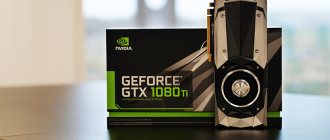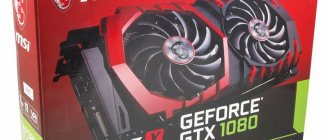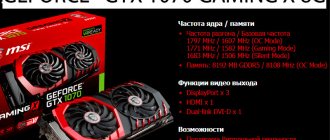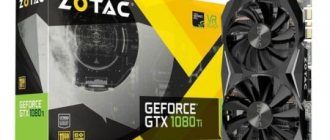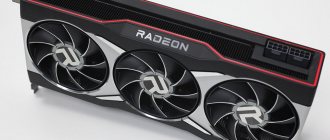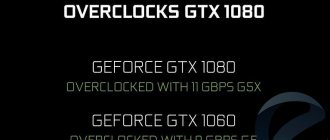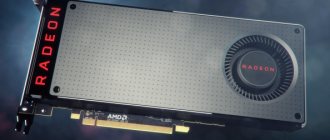First, modern graphics cards connect to the PCIe x16 expansion slot, which is powered by the motherboard's 24-pin connector and provides graphics cards with up to 75W of power. This turns out to be enough for entry-level and mid-level video cards. Such cards do not have additional power connectors and are not very demanding on the power supply, and, as a rule, provide relatively low performance.
24-pin motherboard power connector
Secondly, more powerful versions of video cards may have 2 types of power connectors: 6-pin and 8-pin, or both at once. The 6-pin connector provides the video card with additional power of 75 W, and the 8-pin connector provides 150 W. Thus, the maximum power consumption of a video card with 1 8-pin connector and 1 6-pin connector can reach the following value: 75 + 150 + 75 = 300 W (connector configurations may differ, including upwards). You should pay attention to the following fact: for each additional power connector on the video card, the power supply must have a separate power connector. The presence of additional power connectors indicates both increased power consumption of the video card and greater performance (relative to video cards without additional power connectors and within one or two generations). In addition, by the presence of additional power connectors, you can approximately determine the power consumption for which the video card is designed. It is important to remember that if there are several power connectors on the video card, for normal operation of the computer it is necessary to connect a power cable to each connector. Otherwise, the computer will either not turn on or the video card will not operate at its maximum performance.
8-pin and 6-pin connectors
In this regard, it should be mentioned that there are power supplies with separated 12 V power lines. This means that each connector (6-pin and 8-pin) will serve its own power line. You can read more about this in our FAQ on power supplies.
To summarize, to properly power your video card, you need to understand what power connectors it requires and what maximum power it consumes. Taking these factors into account will allow you to avoid an unpleasant situation in which your system cannot start due to lack of power or lack of necessary connectors. Enjoy the shopping!
The ATX12V 2.x specification uses a new 24-pin motherboard power connector that provides more power to power various on-board controllers and PCI-E cards. The specification is designed for an additional 75 W of power directly for the PCI-E x16 slot and this power, in principle, is enough for many video cards with average performance. But high-end graphics cards typically require higher power levels. For this reason, the PCI-SIG (Special Interest Group) development group has introduced two standards for providing additional power to PCI-E video cards, which involve the use of the following connectors:
- PCI Express x16 Graphics 150 W-ATX - specification published in October 2004. An additional 6-pin (2x3) connector is used, which provides an additional 75 W of power. The total power of the PCI-E x16 slot reaches 150 W.
- PCI Express 225 W/300 W High Power Card Electromechanical - specification published in March 2008. Assumes the use of an 8-pin (2x4) additional power connector, providing an additional 150 W of power. The total power is 225 W (75+150) or 300 W (75+150+75).
To video cards that require even more energy, you can connect several connectors at once:
| Change the font to normal | short link to news: ↑ next news | previous news ↓ |
#Power_connector for video cards
Power for a fast modern video card can come from 3 sources: | |
| Power connector type | The power it provides |
| PCIe x16 | 75 W |
| 6-pin | 75 W |
| 8-pin | 150 W |
| PCI-E additional power connector configurations | |
| Maximum power | Additional configuration nutrition |
| 75 W | Not used |
| 150 W | 1 x 6-pin |
| 225 W | 2 x 6-pin or 1 x 8-pin |
| 300 W | 1 x 8-pin + 1 x 6-pin |
| 375 W | 2 x 8-pin |
| 450 W | 2 x 8-pin + 1 x 6-pin |
Additional power for PCI Express cards is provided using 6-pin (2x3) or 8-pin (2x4) Molex Mini-Fit connectors, equipped with a female plug that connects directly to the video card. For reference, these connectors are similar to the Molex 39-01-2060 (6-pin) and 39-01-2080 (8-pin), but both use different keys to prevent the possibility of them being mistakenly installed in the +12 V connector on the motherboard board. The following diagram shows the layout of the connectors, including the plug side. Pay attention to the “sense” signal on pin 5 - it allows the graphics card to determine whether the connector is connected. Without proper power levels, the card may shut down or operate in a mode with limited functionality. Also note that pin 2 is designated in the table as N/C (No Connection) according to the standard specification, but most power supplies seem to also supply +12 V.
Maximum permissible power
First, let's remember the physics lessons from the school curriculum. There was this formula:
Power is designated by the letter P and is measured in Watts (W). Current strength is designated by the letter I and is measured in Amperes (A). Voltage is designated by the letter U and measured in Volts (V). I will use this formula for all calculations in this material.
When in the article I talk about the maximum permissible power, this should be understood as a limitation imposed by the developers of the power connector. On thematic forums you can often find messages from the series “I connected a bunch of video cards via one PCI-E and everything is fine with me.” With high-quality materials, indeed, this configuration can work for some time, if the author of the message is a thrill-seeker. With low-quality materials, problems may occur even before the maximum current allowed by the standards flows through the adapter.
It is also worth immediately defining the terms. The power connection is the connection of a paired device, that is, consisting of two parts. These parts may have different names in documentation and in colloquial speech. The socket part, as a rule, is located on the device (unless we are talking about adapters, extension cords, etc.). It can be called: socket, female, “mother”, connector, socket. The male part is usually located at the end of the cable and is called: plug, male, male, plug, connector. All these names are widespread and have the right to life. In this article I will use the names “connector” and “socket”.
Some may consider this incorrect, but I will use terms that are familiar to me, so as not to make mistakes myself and not confuse you.
Now let's talk about the connectors that can be found on a modern power supply.
USB plug pinout (regular, mini, micro).
USB (Universal Serial Bus) - The USB data transfer interface is widespread today, used in almost all devices - phones, PCs, MFPs, tape recorders and other devices - used both for data transfer and for charging phone batteries.
Types of USB connectors.
There are a large number of types of USB connectors. All of them are shown below.
Type A - active, power supply device (computer, host). Type B - passive, connected device (printer, scanner)
USB cable pinout by color.
USB 2.0 pinout.
USB is a serial bus. It uses 4 shielded wires: two for power (+5v & GND) and two for differential data signals (labeled D+ and D-).
USB micro
USB micro has been used since 2011 in phones, MP3 and other devices. Micro is a newer variation of the mini connector. It has the advantage of connecting connectors, the connector is connected tightly to the plug and provides a tight connection.
Motherboard power connector (ATX connector)
There are 20-pin and 24-pin motherboard power connectors. Farms use 24-pin ones, but for compatibility with older motherboards, the four outer contacts are often made detachable. The type of power connector on the motherboard must match the type of power supply connector.
In relation to mining about this connector, it can be noted that four additional contacts are used to power PCI-Express devices; they provide power up to 75 Watts.
Is it possible to power a 6-pin riser from an 8-pin connector?
To power the riser, you can use the 6-pin part of the 8-pin PCI-E power connector.
To do this, you need to insert the 8-pin connector so that its pins 1-3 and 5-7 fit into the riser power connector, then they will fully correspond to the six-pin connector:
In fact, part of the 8-pin connector will be inserted into the riser, as if it were a regular 6+2 power connector for VGA devices:
In a similar way, you can power devices with an 8-pin connector from a 6-pin cable, but in this case the protection for the presence of the sense signal may be triggered (which guarantees the presence of three 12 V power pairs) and they will not work.
Picture of connecting a 6-pin power cable to a device with 8-pin power:
CPU Power Connector
There are 4-pin and 8-pin connectors. From the diagram below it is easy to see that the 8-pin is two 4-pin located next to each other. Often the 8-pin one is made composite, similar to the motherboard power connector.
On power supplies, the processor power connector is located on a separate line. Sometimes there is both an 8-pin (non-separable) and a 4-pin on this line at the same time. One of them is connected to the motherboard.
PCI-E connector
It is this connector that is designed to power video cards; power supply manufacturers often make them red (and some blue) in color; there are 6-pin and 8-pin. In modern power supplies, the 8-pin can be composite, just like the connectors described earlier.
The PCI-E connector is the most popular in mining. Its purpose is to provide additional power to devices (video cards, in our case) connected to the PCI-Express bus of the motherboard. According to the specifications, the 6-pin provides 75 watts of additional power, and the 8-pin provides 150 watts. At the same time, the video card receives another 75 watts from the motherboard (or from the riser).
Course on video cards for mining:
The video card may have several connectors for additional power. For example, you can take the NVIDIA GeForce GTX 980 Ti video card; its maximum power consumption, according to the manufacturers, is 250 Watts. Of this, the device receives 75 Watts from the motherboard, and connectors for at least 175 Watts are required. One 6-pin is not enough (up to 75 Watt), one 8-pin or two 6-pin (up to 150 Watt) is also not enough. Requires one 6-pin and one 8-pin (total 225 watts). Look at the picture below - that’s right, everything is correct.
What is this?
In most cases, power supplies are included with your laptop or computer. They are installed in a computer case. If the buyer focuses on the external data of the PC, forgetting about the technical characteristics, this may lead to the inability to install a more powerful video card or additional disk in the future. The main reason may be a lack of connection connectors.
The main elements of the PC are connected to the power supply. The number of connectors determines how many devices will be connected to it. Its main task is to supply energy to the processor, memory, video card, hard drive and other elements. The power reserve of the power supply allows it to operate in optimal conditions without overload. Today you can find units of varying power on sale (from 150 to 1500 Watt). The average unit power range to stick to is 450 watts. When buying a laptop, consider its weight. If the device is light, then the power supply is unreliable, and vice versa.
The main elements of a PC are divided into modular and standard. Modular connecting parts are placed on the cables by the manufacturer. They can be detached and attached as needed. For standard units, the connectors are located on cables that cannot be removed. 8 pin is an adapter that is used to connect the central processor. Many motherboards have a 4 pin connector. Often an eight consists of two fours. There are also 15 pin, 8 pin, 6 pin connectors.
Molex connector
Initially, this connector was designed to power hard drives and floppy drives, but currently for modern devices this function is performed by SATA connectors (about them below), and Molex connectors are used to power various additional equipment.
The advantage of Molex is the presence of 5 and 12 Volt lines at the same time, and a current of up to 11 Amps can flow through each line, that is, the power of a 12-Volt line is 132 Watts, and a 5-Volt line is 55 Watts. You can often find information on the Internet that Molex provides 187 watts of power. This is true, but the additional power connector for video cards has only 12 Volt lines, and the 5 Volt line is not used. In mining rigs, Molex connectors are used to connect risers, cooling fans, additional power to the motherboard, and as a replacement for missing PCI-E connectors.
Many adapters have been invented using Molex. And some of them pose a real fire hazard!
The top most fire-hazardous adapters are headed by the MOLEX->8-pin PCI-E adapter. The power consumption of the video card via the 8-pin connector, as I noted above, is up to 150 Watts. Molex is rated at 132 watts.
Molex->6-pin PCI-E and 2xMolex->8-pin PCI-E adapters should be used with caution. There is no excess in power here, but you shouldn’t relax. Adapter manufacturers often use low-quality materials - thin wires, cheap plastic, unreliable metal parts. This may also cause a fire. After installing such connectors, regularly monitor their condition.
The safest option is 2xMOLEX->6-pin PCI-E adapters. A good power reserve allows you to avoid fire due to overheating, but there is still a danger of problems arising due to poor contact, as a result of which this adapter will actually turn into a 1xMolex->6-pin PCI-E, and this is the first step to big problems.
It is advisable to avoid using Molex adapters to connect video cards. However, it is relatively safe to use Molex connectors to power risers (let me remind you, their consumption is no more than 75 Watt), including using adapters.
Purpose
8 pin is an adapter that is designed to power a video card located in a computer. The amount of energy consumption by a video card depends on the manufacturer, purpose, series and other parameters. Power fluctuates widely. To provide power to the video card and other components, the device will need sources. The most common are PCIe x16, 6 pin, 8 pin. The adapter is needed not only for the video card; the power supply for other elements in the computer depends on it. It provides maximum PC performance.
SATA connector
Like MOLEX, this connector is designed for connecting hard drives and floppy drives.
From the diagram it can be seen that the connector has three contacts for 3.3 V, 5 V, 12 V. According to the specification, each connector is designed for a maximum current of 1.5 A. Thus, the total power of the 3.3 V lines is almost 15 Watts, 5 V lines are 22.5 Watts, and 12 V lines are 54 Watts. Thus, the maximum power of the 12 V line for this connector is three times less than that of Molex. And the 5 V lines are two times smaller.
That is, you CANNOT use SATA->Molex connectors to power devices that consume more than 50 Watts.
Reference information on the wires in the power cables of VGA devices
Video card power cables can use AWG wires marked from 16 to 24:
Maximum current through power cables, depending on the wires used, in amperes:
Information on the maximum permissible current for AWG wires:
Final figures
To make it more clear, let’s present the values of the maximum permissible power consumption on lines with different voltages in the form of a table.
The following table shows the maximum power consumption of connectors on various devices that can be part of a mining farm.
The resulting tables will allow you to determine which adapters and for what purposes are safe and which are not. For example:
- One 8-pin PCI-E to power the video card (requires 150 Watts via a 12 Volt line, Table 2) can be connected from two 6-pin PCI-Es (a total of 150 Watts via a 12 Volt line, Table 1);
- Two 6-pin PCI-E to power the video card (a total of 150 Watts required via a 12 Volt line, Table 2) can be connected from one 8-pin PCI-E (provides 150 Watts via a 12 Volt line, Table 1).
- One 6-pin PCI-E to power the video card (requires 75 Watts via 12 Volt line, Table 2) can be connected from one Molex (provides 132 Watts via 12 Volt line, Table 1), but it is better from two, given the low quality of such adapters.
- One 6-pin PCI-E to power the riser (requires 75 Watts on a 12 Volt line, Table 2) can be connected from one Molex (provides 132 Watts on a 12 Volt line, Table 1).
- Two risers with any connectors (requiring a total of 150 Watts) can be connected from one 8-pin PCI-E.
I gave these examples. But do not forget that in this matter a lot depends on the quality of the materials from which they are made. If possible, try to avoid using them.
Do you want to make money on crypto? Subscribe to our Telegram channels!
Mini-USB 8 pin Digital Camera connector pinout and description @ pinoutguide.com
| Pin Number | Pin Name | Description |
| 8 | GND | |
| 7 | Video Out | |
| 6 | Audio Out L | |
| 5 | GND | |
| 4 | USB Data + | |
| 3 | Audio Out R | |
| 2 | USB Data - | |
| 1 | USB Vcc |
Pins except USB signals may be varied - depending on camera model.
The Nikon cable called UC-E6, Olympus - CB-USB7
Should be compatible with:
Fuji digital cameras with 8 pin usb
Fuji Fujifilm Finepix A100, A150, A170, A850, A860, AX245W, F20, F30, F31fd, F31 fd, F40 fd, F40fd, F45 fd, F45fd, F47 fd, F47fd, F50 fd, F50fd, F60fd, F60 fd, F70 EXR , F70 EXR, F72 EXR, F72EXR, F100fd, F100 fd, F460, F470, F480, F650, HS10, J10, J12, J15fd, J15 fd, J20, J22, J25, J26, J27, J28, J29, J30, J32 , J37, J50, J100, J110W, J110 W, J120, J150W, J150 W, J210, J250, JX200, JX210, JX530, JZ300, JZ305, JZ310, JZ500, JZ505, JZ510, W3 (3D) Digital Camera
On the Fujifilm AV150, Pin 3 (labelled Audio Out R on your webpage) must be tied to ground to enable video out.
Konica Minolta digital cameras with 8 pin usb
DiMage A Series A200, DiMage E Series E323/E500, DiMage X Series X50/X60, DiMage Z Series Z10/Z20/Z3/Z5/Z6, Dynax 5D/7D, Maxxum 5D/7D
Olympus digital cameras with 8 pin usb
FE series FE-150 / FE-160 / FE-180 / FE-190 / FE-20 / FE-220 / FE-230 / FE-240 / FE-25 / FE-250 / FE-26 / FE-280 / FE-290 / FE-300 / FE-3000 / FE-3010 / FE-310 / FE-320 / FE-340 / FE-350 / FE-360 / FE-370 / FE-4000 / FE-4010 / FE- 45 / FE-46 / FE-5000 / FE-5010 / FE-5020, mju 5010 / 7010, Stylus 5010 / 7010, X-Series X-15 / X-730 / X-785 / X-790 / X-795 / X-800 / X-820 / X-835 / X-845
Panasonic digital cameras with 8 pin usb
LUMIX DMC-FS15 / DMC-FS20 / DMC-FS25 / DMC-FS3 / DMC-FS5 / DMC-FS7 / DMC-FS8 / DMC-FX01 / DMC-FX07 / DMC-FX10 / DMC-FX100K / DMC-FX100S / DMC -FX12 / DMC-FX150K / DMC-FX150S / DMC-FX2 / DMC-FX3 / DMC-FX30 / DMC-FX35 / DMC-FX37 / DMC-FX50 / DMC-FX500 / DMC-FX7 / DMC-FX8 / DMC-FX9 / DMC-FZ10 / DMC-FZ15 / DMC-FZ18 / DMC-FZ2 / DMC-FZ20 / DMC-FZ28 / DMC-FZ28K / DMC-FZ28S / DMC-FZ3 / DMC-FZ30 / DMC-FZ4 / DMC-FZ5 / DMC -FZ50 / DMC-FZ7 / DMC-FZ8 / DMC-G1A / DMC-G1K / DMC-G1KEB-A / DMC-G1KEB-K / DMC-G1KEB-R / DMC-G1KEG-R / DMC-G1R / DMC-G1W / DMC-G1WEG-A / DMC-G1WEG-K / DMC-G1WEG-R / DMC-L10 / DMC-L10K / DMC-L10KEB / DMC-L10KEB-K / DMC-LS1 / DMC-LS2 / DMC-LS70 / DMC -LS75 / DMC-LS80 / DMC-LS85 / DMC-LX1 / DMC-LX2 / DMC-LX3 / DMC-LZ1 / DMC-LZ10 / DMC-LZ2 / DMC-LZ3 / DMC-LZ4 / DMC-LZ5 / DMC-LZ6 / DMC-LZ7 / DMC-LZ8 / DMC-TZ1 / DMC-TZ11 / DMC-TZ15 / DMC-TZ2 / DMC-TZ24 / DMC-TZ3 / DMC-TZ4 / DMC-TZ5 / DMC-TZ50-K / DMC-TZ50 -S/DMC-GF3
Pentax digital cameras with 8 pin usb
ist Series ist DS / ist DS2, K Series K100D / K10D / K110D / K-2000 / K-200D / K-20D / K-7 Optio 33WR / 43WR / 450 / 50 / 550 / 555 / 60 / 750z / A10 / A20 / A30 / a40 / E10 / E20 / E30 / E40 / E50 / E60 / E70L / E75 / E8 / M10 / M20 / M30 / M40 / M50 / MX / MX4 / S / s10 / S12 / S4 / S40 / S45 / S4i / S50 / S55 / S5i / S5z / S6 / S60 / S7 / SV / SVi / T10 / T20 / T30 / V10 / W10 / W20 / W30 / W60 / WP / WPi / X, ist DL
Sony digital cameras with 8 pin usb
Alpha A100 / A200 / A230 / A300 / A330 / A350 / A700 / A900, CyberShot S Series DSC-S630 / DSC-S650 / DSC-S700 / DSC-S730 / DSC-S750 / DSC-S780 / DSC-S800 / DSC- S950, CyberShot W Series DSC-W180 / DSC-W190
Vivitar
ViviCam 3000 / 4345 / 4385 / 5385 / 5386 / 6300 / 8300 / 8300S
pinoutguide.com

